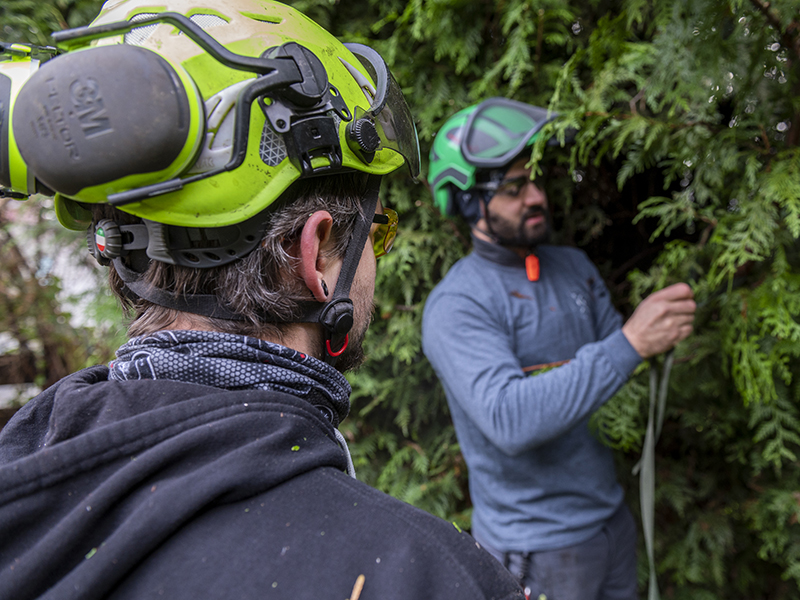Planting trees can be the first step in making your house the home you’ve always wanted. When you plant a newly planted tree, proper tree care starts with ensuring the soil and root system are supported: keep the soil around the root ball moist but not waterlogged, and maintain soil moisture, especially when rainfall is insufficient. Apply a layer of organic mulch around the base of the tree, leaving a few inches of space away from the tree trunk and tree roots so the bark and root flare remain safe. Young trees often need watering with a soaker hose or watering bags, monitoring soil temperature and moisture, especially during dry spells. When planting, ensure the planting hole is properly dug, the root ball is placed at the correct depth, and mulch is layered about 6 inches away from the trunk’s base. With careful maintenance, watering, mulching, and the occasional light prune or shrub care, your tree and shrubs get the best start toward becoming healthy, established trees.

With the many scientific, practical, aesthetic, and regulatory factors involved in planting a new tree, a certified arborist’s services can save you a lot of trouble and money in the long run. Here is our comprehensive guide to help you get started in the meantime.
The Right Tree at The Right Place
Before anything else, consider the tree that best suits your property and where you could plant trees.
To better narrow down your choices, here are some factors to consider:
Height and Width
The mature height of your tree can be a practical and aesthetic choice.
However, you should consider how it may cause obstructions in the future.
For example, in Vancouver, trees with a mature height over 25′ cannot be planted under power lines.
Because Vancouver’s growing conditions are favourable, add 20% to the projected mature height of a given tree.
The width of the canopy can also create obstructions or affect the shade your house receives.
It, in turn, will result in a cooler home in the hot season.
Source of Nutrients
The planting site must have the right resources to allow your chosen tree to thrive.
How your tree receives sunlight, moisture, and other nutrient sources will impact its health as it develops.
With Vancouver’s diverse soil conditions, you may benefit from a professional site assessment to ensure the soil can support your new tree.
Soil tests can be a wise investment. They can indicate necessary soil amendments, give your tree the best start, and protect your financial investment.
Fruiting, Climate, and Seasons
With the right care, fruit trees can thrive in Vancouver.
They will give you fresh fruit, enhance your landscape, and add value to your property.
On the flip side, they’re more demanding regarding care and maintenance.
Fungal issues, both foliar (relating to leaves) and root-borne, are prevalent in Vancouver.
Selecting less prone trees and having routine maintenance is vital to your tree’s long, healthy life.
Another consideration is how your chosen trees react to changes in season or climate.
Choose whether you prefer deciduous plants that shed leaves in the winter or evergreen trees that retain them.
When selecting trees, always consider the hardiness zone of your area.
It gives you an idea of how likely your tree will be to survive based on the temperature extremes expected in your area.
Vancouver has a temperate ocean climate, dry and warm in the summer and rainy between October and March.
When to Plant a New Tree in Vancouver
Planting your new tree in Vancouver during the fall is usually best, ideally the last two weeks of October and the first week of November.
It’s the ideal growing season because the soil’s warmth can promote root growth.
The higher moisture levels and beneficial fungi and bacteria can support your tree’s needs.
Watering Your New Tree in Its First Year
The first year of a newly planted tree is critical for establishing its long-term health, root development and structural integrity.
It’s the establishment period during which tree roots develop, so you must ensure the tree gets enough water and nutrients.
Proper watering of your new trees is crucial.
Download The Tree Owner’s Manual
During these early stages, too much water can be just as harmful to your tree as a lack of it. The symptoms of both can be very similar.
Water is best absorbed by new trees when allowed to flow slowly over a period of time.
Spray heads on garden hoses lose too much water to the atmosphere and contribute to fungal issues.
Implement slow-drip techniques like a drip irrigation system, a soaker hose, or a watering bag.
The Soil Test
You can also do a soil test to ensure your tree receives the right amount of water.
Soil moisture is a critical factor in growing a healthy tree.
Grab some of the soil around your tree’s base. It should be moist but not wet or dry.
You’re watering too much if you squeeze the soil and water drips.
If you blow on the soil and it scatters, add more water.
Protect and Nourish Your Tree with Mulch
Tree mulch is a mixture of organic or inorganic materials placed over the soil around your tree.
While it’s unnecessary, mulching your tree offers benefits that are too good to pass up.
- It retains moisture.
- It improves soil conditions.
- It suppresses weed growth.
You can make mulch with wood chips, pine straw, shredded bark, or leaf mulch.
Apply it evenly to the soil, 3 to 4 inches away from the base of the tree, as far as you expect the canopy to grow.
It’s important not to put the mulch layer too close to the root flare, or you will suffocate the tree’s roots.
The root flare is where the first main roots attach to the tree trunk.
Maintaining a hands-width gap between the root flare and the mulch is a good standard.
Protecting Your Tree from Common Vancouver Tree Problems
Vancouver boasts thriving urban forests, but they are not without their challenges.
Natural events and human error will test your new tree as it grows.
Some of the common challenges to trees here in Vancouver include:
- Strong winds.
- Droughts and extreme temperatures.
- Tree diseases and pests include oak wilt, western hemlock looper moths, and aphids.
- Mechanical damage from vehicles and standard equipment in the garden, like string trimmers and lawnmowers.
You can also fence around the tree to shield it from hazards like gardening equipment.
It also protects the soil from foot traffic that can cause soil compaction.
Diseases and pests are more pressing concerns that you should not deal with alone.
It’s best to get the help of a professional arborist so your tree can get proper treatment.
What to Do When Winter Comes?
Another common concern for new tree owners is the effects of the winter months on a growing tree.
The cold season can damage your tree, and the lack of moisture may interfere with its growth.
To help retain the soil’s moisture, you can put mulch made with undyed woodchips or leave any fallen leaves to serve as compost for your tree.
A burlap wrap can also protect your young tree during the winter.
It can keep your trees hydrated when the dry winds blow.
It also keeps the tree free from ice or snow, which can break its branches due to its weight.
Long-Term Care for Tree Health
If the tree is well cared for in its early days of growth, the root ball will develop properly, and its structural integrity will be good for the future.
While it’s more resilient and requires less attention, your tree still needs proper care as it matures.
Healthy trees need regular maintenance services, such as tree pruning and trimming.
Other professional services, such as arborist assessments and deep-root fertilization, can also help ensure your tree receives enough nutrients and is safe from diseases and pests.
Why Work With a Professional Arborist
Living in Vancouver highlights how plants and trees provide practical and aesthetic benefits to its communities.
The shade of street trees, the fresh breeze, and the appealing look of homes surrounded by greenery surely beckon any property owner to grow their own.
However, growing a new tree is only easy with professional assistance.
Due to a young tree’s more delicate nature, even minor errors during its development period can snowball into more significant concerns in the future.
Early errors can result in inconveniences, safety hazards, tree health issues, or even violations of the local tree bylaws in Vancouver.
And, of course, not giving the right care for newly planted trees can waste a lot of money.
Local arborists certified by the International Society of Arboriculture will save you from all this trouble.
An arborist’s professional knowledge, experience, and access to the proper tools remain unmatched when caring for young or mature trees.
